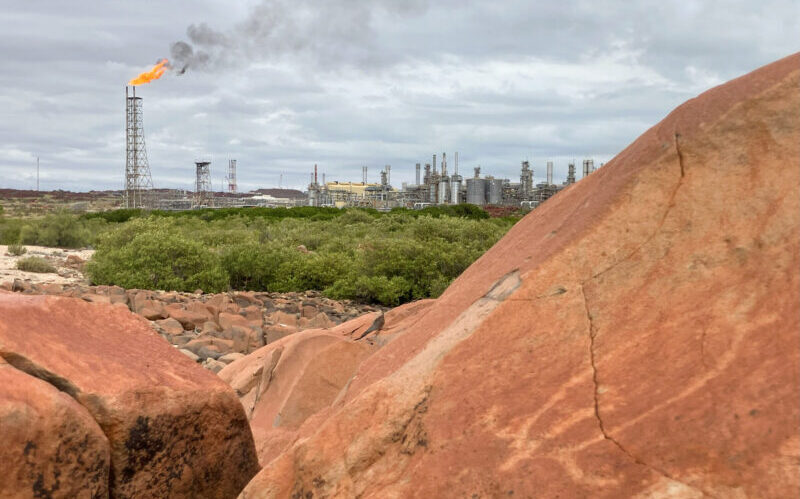Just how much more climate-altering emissions could Woodside’s North West Shelf extension belch into the atmosphere? Zacharias Szumer asks.
Since 2023, MWM has been keeping track of how many fossil fuel projects the Albanese government has approved, but not all fossil fuel projects should be considered equal.
For instance, if the proposed 40-year North West Shelf (NWS) extension goes ahead, it could potentially emit almost twice as many greenhouse gases as all the coal project approvals granted by Labor since 2022.
Environment Minister Murray Watt granted the extension provisional approval in late May, provided Woodside agrees to conditions that at the time of writing are still secret.
The conditions were meant to be made public ten days from Watt granting conditional approval, but have been extended, reportedly until ($) the conclusion of a bid to secure World Heritage listing for nearby ancient rock engravings.
Murujuga heritage status
Some had fought for the granting of heritage status to the Murujuga site should be conditional on addressing chemical emissions from nearby gas plants, a fertiliser plant and mineral export facilities.
The recent granting of the status, with the government only required to continue monitoring the effects of industry on rock art, is a win for those who argue industry and the ‘world’s oldest art gallery’ can coexist.
While the precise conditions remain uncertain, Woodside said in a press release that they included “cultural heritage management and air quality” concerns.
North West Shelf – 4x the coal emissions
Moving from chemical emissions back to greenhouse gas emissions, sometimes a visual aid is necessary to fully grasp the size of Australia’s largest gas project.
As the below graph shows, extending the NWS out to 2070 could potentially create almost four times the direct emissions of all coal project approvals granted by the Albanese government in 2023 and 2024.
Woodside told MWM that the figures are “based on the project operating five LNG processing trains at full capacity” for the entirety of the project, adding that “one train was recently retired”.
“We also expect greenhouse gas emissions will decline towards the end of the project’s life,” the company said in a statement.
Scope 1 emissions are those created by the extraction and refining of fossil fuels, while Scope 2 are those created by the consumption of power needed for extraction and refinement.
Woodside will be forced to reduce or offset both under the Safeguard Mechanism.
Sinners are winners. Is Labor’s Safeguard Mechanism saving the planet?
If precedent is a good basis for prediction, the company will largely do this through offsets rather than reductions. The NWS met its 2023-24 target entirely through carbon offsets.
The company’s Climate Transition Action Plan – which has so far failed to win shareholder support – aims for large-scale abatement to replace offsets as the main source of reductions by 2031.
‘Avoided’ emissions
Australia’s largest contribution to climate change is, by a long shot, emissions from burning the fossil fuels we export.
As the graph below shows, the NWS’s potential export-related emissions also tower above those of other fossil fuel projects approved under Labor, including Santos’ Barossa project, which the government gave the green light to in April.
These so-called scope 3 emissions are essentially treated as irrelevant by fossil fuel companies and the federal government.
Under international climate law, they’re accounted for by the nation in which the final products are burned, something the government has relied upon to defend approving fossil fuel projects that are largely export-focused.
Climate and energy researcher Tim Baxter has argued this defence is based on a faulty premise, and that the government is
trying to spin this load of crap into a silk vest.
“Not one single word of the UNFCCC, the Paris Agreement, and the whole spectrum of COP decisions prohibits you from observing that a country that permits the extraction and sale of fossil fuels during a climate crisis is jointly responsible for the ensuing emissions,” he wrote.
Despite the NWS’ colossal size, emissions from Australian coal exports are, on the whole, far larger than those from gas exports, essentially because we export far more of it.
However, emissions from the gas industry are now growing faster than those from coal, a trend that’s likely to persist as long as governments continue to treat gas as a vital transition fuel.
Data sources:
- NWS emissions statistics taken from NWS Project Extension: Western Australian Environmental Protection Authority, Environmental Review Document: NWS Project Extension – Environmental Review Document.pdf
- Barossa emissions statistics taken from Santos’ Barossa Production Operations Environment Plan: Barossa Production Operations Environment Plan
- Coal project approval emissions taken from Australia Institute’s Gas & Coal Watch
Zacharias Szumer is a freelance writer from Melbourne. In addition to Michael West Media, he has written for The Monthly, Overland, Jacobin, The Quietus, The South China Morning Post and other outlets.
He was also responsible for our War Power Reforms series.

